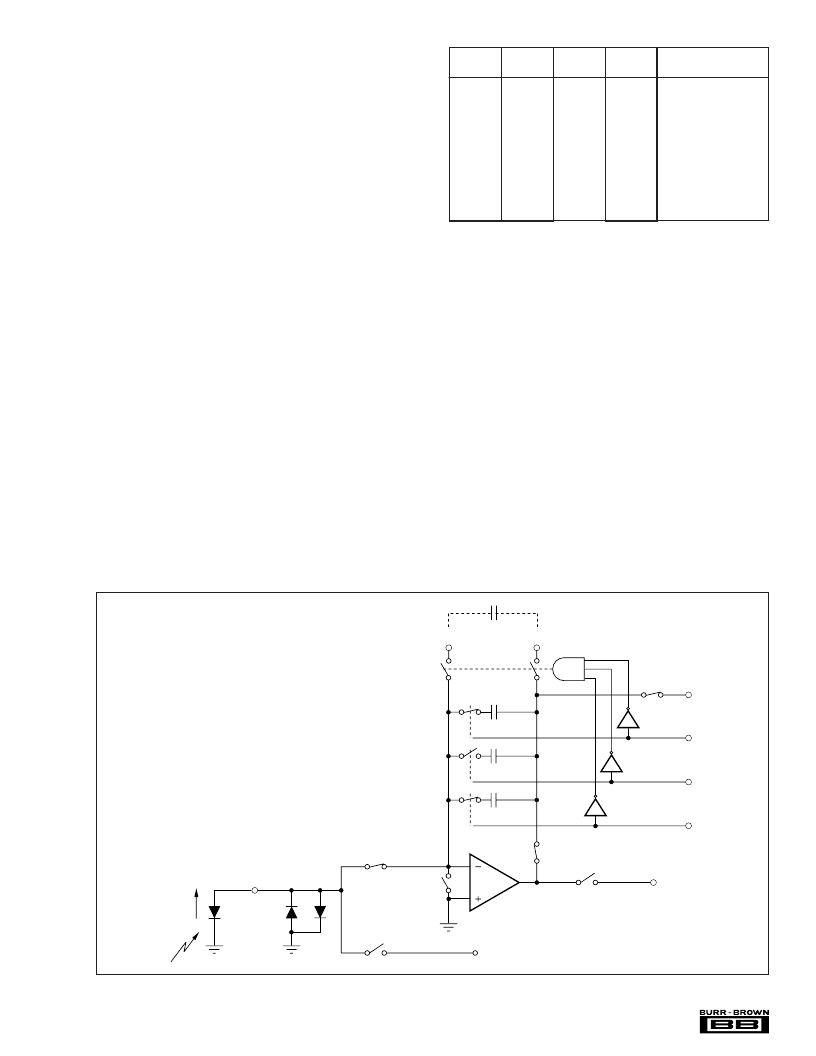- 您現(xiàn)在的位置:買賣IC網(wǎng) > PDF目錄376597 > DDC112UK Dual Current Input 20-Bit ANALOG-TO-DIGITAL CONVERTER PDF資料下載
參數(shù)資料
| 型號: | DDC112UK |
| 英文描述: | Dual Current Input 20-Bit ANALOG-TO-DIGITAL CONVERTER |
| 中文描述: | 雙路電流輸入20位模擬數(shù)字轉換器 |
| 文件頁數(shù): | 7/24頁 |
| 文件大小: | 210K |
| 代理商: | DDC112UK |

DDC112
7
DEVICE OPERATION
Basic Integration Cycle
The fundamental topology of the front end of the DDC112
is a classical analog integrator as shown in Figure 3. In this
diagram, only Input 1 is shown. This representation of the
input stage consists of an operational amplifier, a selectable
feedback capacitor network (C
F
), and several switches that
implement the integration cycle. The timing relationships of
all of the switches shown in Figure 3 are illustrated in Figure
4. Figure 4 is used to conceptualize the operation of the
integrator input stage of the DDC112 and should not be used
as an exact timing tool for design. Block diagrams of the
reset, integrate, converter and wait states of the integrator
section of the DDC112 are shown in Figure 5. This internal
switching network is controlled externally with the convert
command (CONV), range selection pins (RANGE0-
RANGE2), and the system clock (CLK). For the best noise
performance, CONV must be synchronized with the rising
edge of CLK. It is recommended CONV toggle within
±
10ns of the rising edge of CLK.
The non-inverting inputs of the integrators are internally
referenced to ground. Consequently, the DDC112 analog
ground should be as clean as possible. The range switches,
along with the internal and external capacitors (C
F
) are
shown in parallel between the inverting input and output of
the operational amplifier. Table I shows the value of the
integration capacitor (C
F
) for each range. At the beginning
of a conversion, the switches S
A/D
, S
INTA
, S
INTB
, S
REF1
,
S
REF2
, and S
RESET
are set (see Figure 4).
At the completion of an A/D conversion, the charge on the
integration capacitor (C
F
) is reset with S
REF1
and
C
INPUT RANGE
(pC, typ)
RANGE2
RANGE1
RANGE0
(pF, typ)
0
0
0
External
12.5 to 250
Up to 1000
0
0
1
12.5
–0.2 to 50
0
1
0
25
–0.4 to 100
0
1
1
37.5
–0.6 to 150
1
0
0
50
–0.8 to 200
1
0
1
62.5
–0.1 to 250
1
1
0
75
–1.2 to 300
1
1
1
87.5
–1.4 to 350
TABLE I. Range Selection of the DDC112.
FIGURE 3. Basic Integrator Configuration for Input 1 Shown with a 250pC (C
F
= 62.5pF) Input Range.
S
RESET
(see Figures 4 and 5a). This is done during the reset
time. In this manner, the selected capacitor is charged to the
reference voltage, V
REF
. Once the integration capacitor is
charged, S
REF1
, and S
RESET
are switched so that V
REF
is no
longer connected to the amplifier circuit while it waits to
begin integrating (see Figure 5b). With the rising edge on
CONV, S
INTA
closes which begins the integration of Chan-
nel A. This puts the integrator stage into its integrate mode
(see Figure 5c).
Charge from the input signal is collected on the integration
capacitor causing the voltage output of the amplifier to
decrease. A falling edge CONV stops the integration by
switching the input signal from side A to side B (S
INTA
and
S
INTB
). Prior to the falling edge of CONV, the signal on side
B was converted by the A/D converter and reset during the
time that side A was integrating. With the falling edge of
CONV, side B starts integrating the input signal. Now the
output voltage of side A’s operational amplifier is presented
to the input of the
Σ
A/D converter (see Figure 5d).
50pF
CAP1A
CAP1A
25pF
12.5pF
V
REF
RANGE2
RANGE1
RANGE0
To Converter
S
RESET
S
REF2
S
A/D1A
S
INTA
S
REF1
S
INTB
IN1
ESD
Protection
Diode
Input
Current
Integrator A
Integrator B (same as A)
Photodiode
相關PDF資料 |
PDF描述 |
|---|---|
| DDC118 | Octal Current Input 20-Bit Analog-To-Digital Converter |
| DDC118IRTCR | Octal Current Input 20-Bit Analog-To-Digital Converter |
| DDC118IRTCT | Octal Current Input 20-Bit Analog-To-Digital Converter |
| DDG-GJS-K1 | LED GaP |
| DDR-GJS-J2L1-1-I1 | LED GaP |
相關代理商/技術參數(shù) |
參數(shù)描述 |
|---|---|
| DDC112UK | 制造商:Texas Instruments 功能描述:DUAL CURRENT INPUT 20 BIT ANALOG/DIGITAL |
| DDC112UK | 制造商:Texas Instruments 功能描述:20BIT ADC DUAL SMD SOIC28 112 |
| DDC112UK/1K | 功能描述:模數(shù)轉換器 - ADC Dual Current Input 20-Bit RoHS:否 制造商:Texas Instruments 通道數(shù)量:2 結構:Sigma-Delta 轉換速率:125 SPs to 8 KSPs 分辨率:24 bit 輸入類型:Differential 信噪比:107 dB 接口類型:SPI 工作電源電壓:1.7 V to 3.6 V, 2.7 V to 5.25 V 最大工作溫度:+ 85 C 安裝風格:SMD/SMT 封裝 / 箱體:VQFN-32 |
| DDC112UK/1KG4 | 功能描述:模數(shù)轉換器 - ADC Dual Current Input 20-Bit RoHS:否 制造商:Texas Instruments 通道數(shù)量:2 結構:Sigma-Delta 轉換速率:125 SPs to 8 KSPs 分辨率:24 bit 輸入類型:Differential 信噪比:107 dB 接口類型:SPI 工作電源電壓:1.7 V to 3.6 V, 2.7 V to 5.25 V 最大工作溫度:+ 85 C 安裝風格:SMD/SMT 封裝 / 箱體:VQFN-32 |
| DDC112UKG4 | 功能描述:模數(shù)轉換器 - ADC Dual Current Input 20B ADC RoHS:否 制造商:Texas Instruments 通道數(shù)量:2 結構:Sigma-Delta 轉換速率:125 SPs to 8 KSPs 分辨率:24 bit 輸入類型:Differential 信噪比:107 dB 接口類型:SPI 工作電源電壓:1.7 V to 3.6 V, 2.7 V to 5.25 V 最大工作溫度:+ 85 C 安裝風格:SMD/SMT 封裝 / 箱體:VQFN-32 |
發(fā)布緊急采購,3分鐘左右您將得到回復。